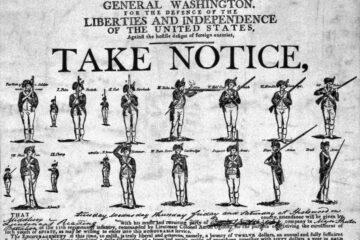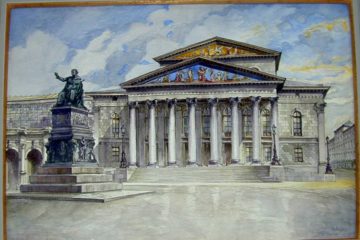Playboys at Work: Forgeries in Science and Religion

by Revilo P. Oliver
IF YOU ARE NO longer young, you may have read as a child a book about the aborigines of the Western Hemisphere, who entered a new world at a time when the level of the oceans was lower and it was possible to walk across the gap that is now the Bering Straits. And you probably learned that those first immigrants had, like the famous Cro-Magnon people of Europe who were our ancestors, artistic instincts, as witness a sketch drawing of a mammoth on a whelk shell known as the Holy Oak Pendant.
If you are a member of the American Association for the Advancement of Science and receive their general periodical, Science, you saw that “pendant” reproduced on the cover of the issue for May 1976 to introduce the lead article, by two American anthropologists, who rejoiced that the ‘Palaeoindians,’ as they are now called, had artistic talents, (1) and who thought the precious artifact must be at least eleven thousand, and might be forty thousand, years old.
(1. It was, strictly speaking, the only evidence of the Indians’ capacity for the mimetic arts, which are efforts to portray realistically in painting or sculpture living beings or natural scenes. The Indians of North America produced more or less geometrical designs on wampum or blankets, and the far more advanced Mayas and Aztecs did produce representations of human figures, all of which, with the exception of some examples that are the subject of debate about possible visitors from the Eastern Hemisphere, are so grotesquely distorted that they are symbols rather than art. The Mochica of Peru are admittedly exceptions: their pottery, now famous, perhaps because so much of it depicts sexual activity, does essay to portray human beings and animals, and their Nazca conquerors may have learned from them.)
The precious “pendant,” according to the records, was discovered in Delaware, at a place called Holy Oak, in 1864 by a young American, precociously interested in the vestiges of the aborigines, who did some excavating a few years before he went to Paris to study fine arts and archaeology. He returned to this country and was Dr. Hilborne Cresson when he became a member of the staff of the famous Peabody Museum at Harvard in 1887. In 1889 he gave his treasure, the engraved whelk shell, to the curator, Professor Frederic Ward Putnam, who accepted it for the Museum but did not become greatly excited by the discovery, although it was proof that (a) “palaeolithic” Indians had reached this hemisphere before the mammoths became extinct, and (b) that they resembled the palaeolithic Cro-Magnons in one uncommon characteristic.
Although the matter was in doubt in 1889, it is now known that, at least in the western part of North America, Indians coexisted with mammoths for a fairly long time before the latter became extinct about 10,500 years ago. Some anthropologists, indeed, credit the “Clovis people” with having hunted the great animals to extinction. The shell, therefore, retains significance only for the drawing on it.
The discoverer of the artifact was born, at a date of which there is no record, as Hilborne Jones and must have had parents who could finance his years of study (and, no doubt, pleasure) in Paris. In 1875, however, he replaced his too common gentile name with the more distinctive and “aristocratic” name of the girl who was attached to the money he married, thus becoming Hilborne T. Cresson. He was the assistant director of field work for the Museum and presumably flourished, both scientifically and socially, until he was discharged for theft of some of the artifacts discovered in excavations. In 1894, evidently brooding over his disgrace, he blew out his brains, leaving a note that stated that he was being hounded by the Secret Service, which suspected him of counterfeiting.
The article in Science aroused the scepticism of William Sturtevant, Curator of North American Ethnology in the Smithsonian Institute. He and his younger associate, David Meltzer, undertook an investigation and noted that the drawing of the mammoth on the unique pendent was practically a copy of drawings made by the Cro-Magnons, and, on the basis of other evidence, suggested that the whelk shell probably dated from c. A.D. 1000. They expressed their doubts in 1985, to the indignation of the authors of the featured article. The shell was then dated by the technique that was used to prove that the “Holy Shroud of Turin” was a hoax, i.e., by spectrometry to fix a radiocarbon date, at a laboratory in Zurich. The whelk formed its shell around A.D. 885 or possibly, given the margin of error in the determination, as late as c. A.D. 1000. That, of course, settles the question; Jones-Cresson, like the manufacturer of the “Piltdown man,” (2) was a forger who sought eminence by perpetrating a hoax.
(2. Cf. Liberty Bell, September 1990, pp. 10-19.)
The determination of the date was published in American Antiquity July 1988, and the affair was summarized by David Meltzer in the New Scientist, 14 July 1990. The authors of the feature article in Science were polemically irate in 1988 and presumably still are. That will tell you something about the present state of scientific research.
Jones-Cresson forged to make himself prominent. There is, so far as I know, no indication of a purpose to exalt the aborigines. That acquits him of a more serious offense, complicity in efforts to denigrate our race by lying about the achievements of savages, a kind of mental poison that I shall consider on another occasion.
* * *
In my article on the Piltdown hoax I expressed the opinion that Professor Smith Woodward was probably the dupe, not an accomplice, of the forger. I am glad to see that opinion confirmed in a letter to the editor of the New Scientist, published in the issue for 24 November 1990. The writer quotes from an article published in that magazine in 1981.
One of the persons on the margin of the Piltdown affair was a shrewd young man named Martin Hinton, who was not deceived by the hoax, but whose efforts to expose it were ignored because he lacked the academic credentials to qualify as an expert and partly, no doubt, because he did not behave with the courteous respect for others’ opinions that was required by gentlemanly exercise of scientific investigation.
Hinton finally procured a leg bone of an extinct species of elephant and carefully carved it in the shape of one of the bats used in playing cricket, the British analogue of American baseball. (The bats used in cricket are more distinctively shaped than the ones used in baseball.) He then planted it where Professor Smith Woodward would be sure to find it.
Hinton, we may be sure, expected Woodward to explode in wrath as he recognized the obvious hoax, and also, on reflection, to become more cautious in joyously accepting such “finds” as the Piltdown skull as authentic.
What happened was that Professor Woodward “found the artifact, just as he was meant to, but instead of turning red with chagrin or apoplexy, he solemnly pronounced it to be ‘a supremely important example of the work of palaeolithic man.'” What is more, the learned scientist not only accepted the hoax but “went to great length in describing its details, and even thought he had found the remains of a hole pierced through it in which a thong had been threaded to hand it from the imagined Piltdown man’s waistband”!
“At which point,” the writer of the letter remarks sardonically, “Hinton gave up the unequal struggle with the experts.” (3)
(3. I wish it were known whether or not Hinton’s hoax and exposure of Woodward’s gullibility to those who knew of it was reported to the one first-rate scientist who, given his belief in the integrity of Dawson and courteous respect for the work of Woodward, was deceived by the Piltdown forgery, Sir Arthur Keith. (Cf. Liberty Bell, September 1990, pp. 17-18.) I like to believe that if Sir Arthur had learned how gullible Woodward was, he would not have had to confess in his old age that the hoaxers had “made a fool” of him.)
That is more than an amusing story: it exemplifies a phenomenon that is all too common. There are many men in whom an accumulation of knowledge in their own field of study blights their common sense and renders them far more gullible than observers who have only a superficial acquaintance with their subject. Of this we have had many recent proofs; probably honest men of scientific training have been bamboozled by the tricks of such charlatans as the clever Jew boy, Uri Geller, (4) and it was necessary for a real magician, notably the indefatigably incredulous James Randi, to expose the swindle. The moral to be drawn is that we should never lightly trust a specialist.
(4. Cf. Liberty Bell, June 1987, pp. 4-5)
We must however, sympathize with poor Martin Hinton, whose best efforts to restore common sense were unrewarded.
* * *
According to the myths in the “Old Testament — and we need not here inquire what substratum of historical fact underlies those tales — the twelve tribes of God’s Chosen, after they got possession of Palestine, split into two kingdoms, Israel (5) and Judah, the former containing ten tribes and the latter, two, much holier than the others.
(5. There was a kingdom called Israel; it is mentioned on the famous Moabite stone as having been defeated by the King of Moab.)
The ten tribes of Israelites were deported by Sargon II of Assyria in 721 B.C. and became “lost.” (6)
(6. This is nonsense, of course, an early manifestation of the mentality that creates Holohoaxes. Sargon deported only the ruling class, a small fraction of the population; his purpose was to halt the endless trouble created by the pests as they professed loyalty to him and intrigued with the Egyptians to invade Assyrian territory. If you yearn to meditate on the “lost tribes,” you may do so at great length with Professor Allen H. Godbey’s The Lost Tribes, a Myth (Durham, North Carolina; Duke University Press, 1930).)
In the Jewish story the ten tribes are usually lost, but pop up again when needed. In the Christians’ favorite horror story, the Apocalypse attributed to a John, each of the twelve tribes contributes its share to the swarm of 144,000 male homosexual Jews for whom old Jesus, after he has smashed up and junked the whole universe, will create a new, all-male Paradise, in which they can have fun endlessly without those nasty animals, women.
Ignorant Christians believed the tale about the oddly “lost” ten tribes, and discovered them in all sorts of distant regions. In 1644 a Jew who called himself Antonio de Montesinos (his real name was Aaron Levi) turned up in Holland with the exciting story that he had found the Lost Tribes: they were the Indians of the Western Hemisphere; in proof whereof he claimed to have found in Ecuador a tribe that spoke Hebrew. The story was probably just a typical hoax, (7) but it was believed, at least for its value as propaganda, by Manasseh ben Israel, a Jewish scholar who participated in the negotiations with Cromwell for the readmission to England of undisguised Jews, who then joined forces with the horde of Marranos who had infested England ever since the expulsion of the “unconverted” Jews by the great English king, Edward I. (8)
(7. There is a bare possibility that Levi was deceived by the fact that tones of the voice and gestures often convey meaning when words are not understood. That is one explanation of the well-known report that the Mandan Indians understood some words of Welsh. Since the tribe is now extinct, verification of the story is impossible and we cannot determine the accuracy of the lists of Welsh words that are said to have been in use by the tribe. If you are interested in the possibility that Welsh colonists reached North America long before Columbus, see Richard Deacon, Madoc and the Discovery of America (New York, Braziller, s.a. [1966]).)
(8. Cf. Liberty Bell May 1985, pp. 7-10. 13; November 1985, pp. 24-28.)
Manasseh ben Israel, calculating the probable effect on gullible Englishmen, published Levi’s discovery in 1650, first as Esperanza de Israel in Spanish for the benefit of his fellow Sephardim, (9) and then in Latin for general distribution in England. He thus set off a landslide of fantasies, including Joseph Smith’s Book of Mormon.
(9. Although they spoke Ladino among themselves, they understood Spanish, for Ladino was, for all practical purposes, just a dialect of Spanish, as Yiddish is of German. I have not seen either the Spanish or the Latin text of the little book.)
Now if ten tribes of God’s Own really hied themselves to the Western Hemisphere as soon after 721 B.C. as they could get away from the wicked “oppressor,” Sargon, they must have left memorials of their identity, and it was only a work of piety to provide the necessary artifacts.
In 1860 one David Wyrick, who had a revelation that the numerous Indian mounds in the Ohio Valley must be the work of the Ten Tribes, duly “discovered” a number of small stones, inscribed with Hebrew characters. (10) A few more stones, all bearing short inscriptions in Hebrew letters, were promptly discovered by others, two by a man named John H. Nicol.
(10. I have not seen the stones. If, as is likely, the letters are the square letters used in printing Hebrew today, that is sufficient to reveal the fraud. Although derived from the Aramaic alphabet when that language replaced the Canaanite dialect of Old Phoenician (“Hebrew”) as the common language of Jews in Palestine, the square characters came into use in the Eleventh Century and were not really standardized before the introduction of printing in the Sixteenth Century. The Israelites (Ten Tribes) would have used the alphabet you have seen in pictures of the Moabite Stone.)
Since the wondrous little inscriptions were found near Newark, Ohio, they are known as the “Newark Holy Stones” and viewed with awe by the credulous. Notably among our contemporaries, Professor Robert Alrutz of Denison University uses the Holy Stones to prove that the Holy Race discovered the Western Hemisphere, although he prudently refrains from hauling in all the savages who peopled the two continents before the coming of our race.
I learn from the Skeptical Inquirer, Winter 1991, p. 118, that Professor J. Huston McCulloch of Ohio State University has recently read two of the Holy Stones, which evidently contain the inscribed Hebrew letters Y H NCL. Now the Hebrew letter which is now represented by Y was earlier represented by J in transliterations, and, as you know, in most Semitic languages only consonants are written, thus making possible endless hanky-panky in altering Biblical texts without even changing the spelling, e.g., in the well-known fraud by which the name of the mythical conqueror of Palestine, ‘Jesus,’ became ‘Joshua’ in most English Bibles.
The Holy Stones have doubtless given rise to many learned translations by holy men who were impressed by them, but Professor McCulloch simply supplied the right vowels. The two stones read J.H. N(i)C(o)L.
Poor Mr. Nicol! I do not know how old he was in 1860. He seems never to have had the satisfaction of hearing some learned divine expound the abstruse meaning of that stone in Hebrew and then torpedoing the fakir by reading his own signature. But perhaps he heard such a disquisition with a knowing smile and enjoyed a tacit laugh in his own bosom. I hope so.
* * *
Source: Liberty Bell magazine, March 1991





